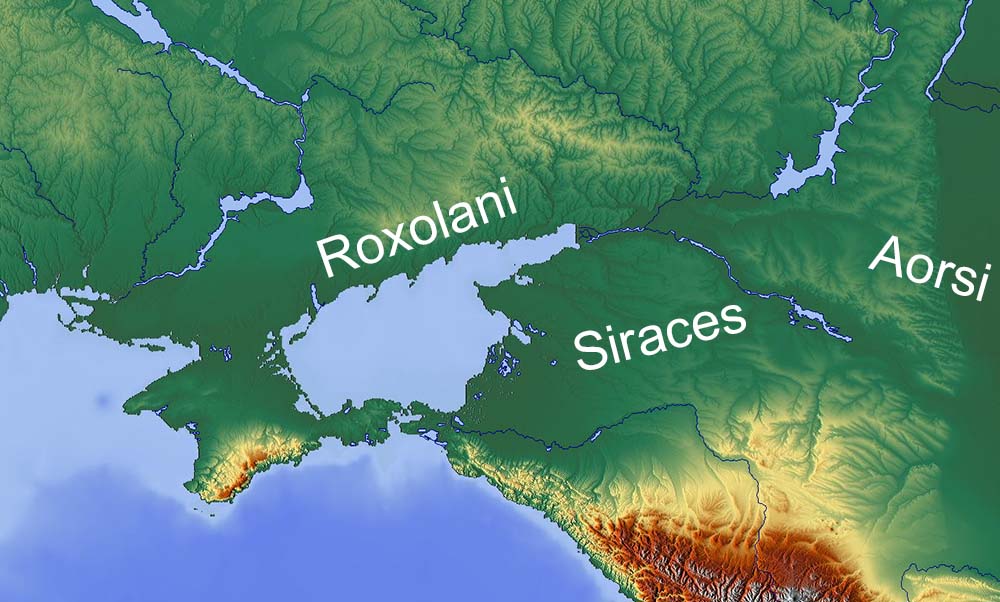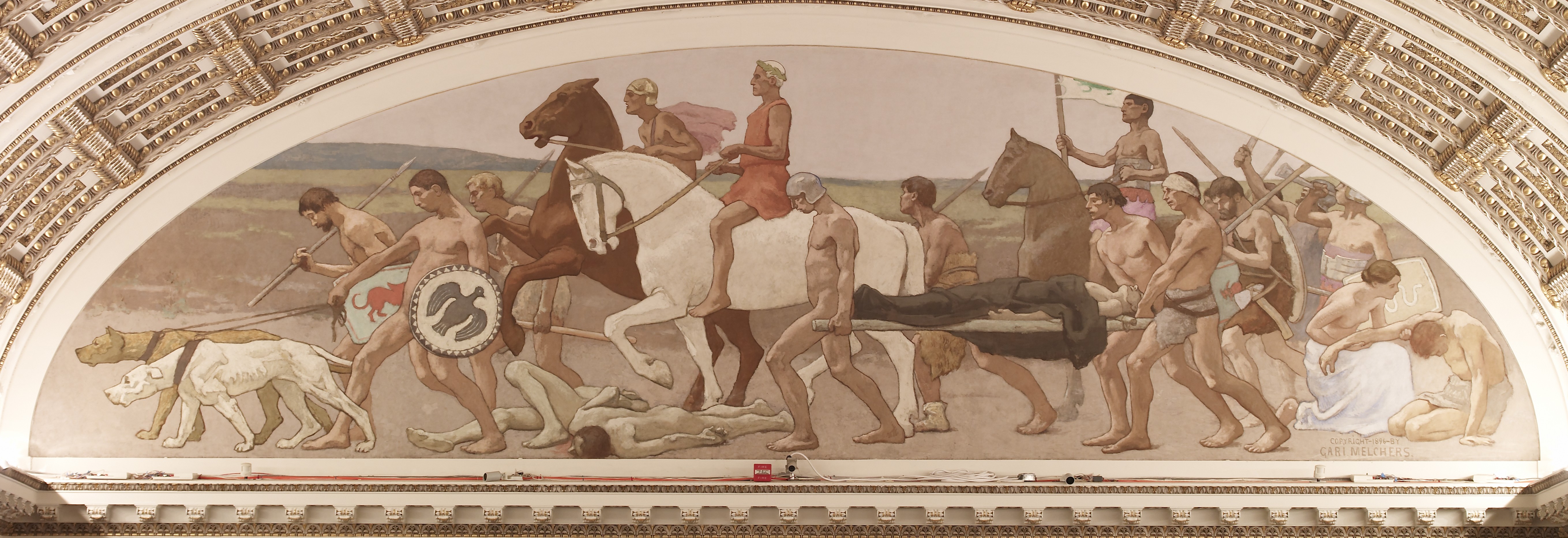|
Siege Of Uspe
The siege of Uspe was a short siege during the brief Roman-Bosporan War between the Siraceni and the Aorsi The Aorsi, known in Greek sources as the Aorsoi (Ἄορσοι), were an ancient Iranian people of the Sarmatian group, who played a major role in the events of the Pontic Steppe from the 1st century BC to the 1st century AD. They are often ... on the weakly fortified stronghold of Uspe. Background and Siege Zorsines had been aiding Mithridates III in his war against his brother Cotys I since 40 AD. The Mithridatic faction had been losing, having lost Artezian to the Roman forces sometime in 45 AD. The siege began after Aorsi commander Eunones crossed the river Panda and noticed that the stronghold had weak defenses that he could use in his favor. Eunones constructed towers to harass the people of the city with darts and arrows to soften their defenses and force them to expedite their surrender. After not being able to take no more, the people of Uspe offered a ... [...More Info...] [...Related Items...] OR: [Wikipedia] [Google] [Baidu] |
Aorsi
The Aorsi, known in Greek sources as the Aorsoi (Ἄορσοι), were an ancient Iranian people of the Sarmatian group, who played a major role in the events of the Pontic Steppe from the 1st century BC to the 1st century AD. They are often regarded as connected to the contemporaneous Eurasian steppe state of '' Yancai'' (or ''Yentsai'') mentioned in ancient Chinese records. The Alans, first mentioned by Middle Eastern and European scholars in the 1st century AD, are regarded as successors of the Aorsi. Name The ethnonym ''Aorsi'' is generally linked to the Avestan ''auruša-'' and the Ossetic ''ūrs'' or ''ors'', meaning 'white'. The names '' Arsīyah'' and ''Arsā'', mentioned by Al-Masudi and Al-Garnati in the 10–12th century AD, may also be related. History The Aorsi and an associated tribe, the Siraces, are believed to have migrated during the late 5th century BC from Central Asia to areas north and west of the Caspian Sea. The territory of the Aorsi is be ... [...More Info...] [...Related Items...] OR: [Wikipedia] [Google] [Baidu] |
Siraces
The Siraces ( gr, Sirakoi, lat, Siraci, also ''Siraceni'' and ''Seraci'' ) were a hellenized Sarmatian tribe that inhabited Sarmatia Asiatica; the coast of Achardeus at the Black Sea north of the Caucasus Mountains, Siracena is mentioned by Tacitus as one of their settlements. They were said to be relatively small nation but with great morale. (bad link as of 20feb16, probably Brzezinski's book.) They were neighbours to the later enemy tribe of Aorsi. They migrated from the Caspian Sea to the Black Sea region. By the late 4th century, they had occupied lands between the Caucasus mountains and the Don, becoming masters of the Kuban region. They were the first Sarmatian tribe to have contact with the Hellenic groups on the coast of the Black Sea. In 310–309 BC, their king Aripharnes took part in the Bosporan Civil War and lost at the battle of the River Thatis (a tributary of the Kuban river). In the 1st century BC during the rule of Pharnaces II of Pontus, King of Siraces ... [...More Info...] [...Related Items...] OR: [Wikipedia] [Google] [Baidu] |
Zorsines
Zorsines was a 1st-century King (''rex Siracorum'') of the Siraces mentioned in Tacitus' ''Annals'' of the Roman Empire (XII.15-19) around 50 AD, a people he reports as residing somewhere between the Caucasus mountains and the Don river. He had a fortification at Uspe. He fought in the Bosporus under Mithridates III, the former king of the Bosporan Kingdom, against the Dandaridae. His ally Mithridates later turned against and fought the Romans in 47 / 48 AD who had put him on the throne earlier in 41. Mithridates eluded the Romans and managed to recover his kingdom. The Aorsi under Prince Eunones, sent by Gaius Julius Aquila and Cotys was sent after Mithridates and his lands, later clashed with Zorsines, besieging Uspe in 49 AD (The town offered 10,000 slaves for their capitulation but the assault continued as the Romans declined). Zorsines finally decided to leave Mithridates to rule his paternal lands, after giving hostages to the Romans and thus making peace. He acknowledg ... [...More Info...] [...Related Items...] OR: [Wikipedia] [Google] [Baidu] |
Tiberius Julius Mithridates
Tiberius Julius Mithridates Philogermanicus Philopatris, ''Philopatris'' means "lover of his country" also known as Mithridates III of the Bosporus (fl. 41 AD, died 68 AD), was a Roman client king of the Bosporus. Ancestry Mithridates was the first son of the Roman client king Aspurgus and his consort Gepaepyris. He had a younger brother who would go on to succeed him as Cotys I. He was a prince of Greek, Iranian and Roman ancestry. He was the first grandchild and grandson of Asander and Dynamis of the Bosporus and Cotys VIII and Antonia Tryphaena of Thrace. Through his maternal grandmother Antonia Tryphaena, he was a descendant of Roman triumvir Mark Antony. Tryphaena was the first great-granddaughter born to Antony. Through Tryphaena, Mithridates was also related to various members of the Julio-Claudian dynasty. Through Aspurgus, Mithridates was a descendant of the Greek Macedonian kings: Antigonus I Monophthalmus, Seleucus I Nicator and the general and statesman An ... [...More Info...] [...Related Items...] OR: [Wikipedia] [Google] [Baidu] |
Tiberius Julius Cotys I
Tiberius Julius Cotys I Philocaesar Philoromaios Eusebes, ''Philocaesar Philoromaios Eusebes'' means "lover of Caesar, lover of Rome who is the pious one" ''Philopatris'' means "lover of his country" also known as Cotys I of the Bosporus (fl. 45–63 AD), was a Roman client king of the Bosporan Kingdom. Life Cotys I was the second son of Roman client rulers Aspurgus and Gepaepyris. His eldest brother was prince and King Mithridates. He was a prince of Greek, Iranian and Roman ancestry. Cotys I was the second grandson of Bosporan monarchs Asander and Dynamis, and Roman client rulers of Thrace Cotys VIII and Antonia Tryphaena. Through his maternal grandmother Antonia Tryphaena, he was a descendant of Roman triumvir Mark Antony. Tryphaena was the first great granddaughter born to the triumvir. Through Tryphaena, Cotys I was also related to various members of the Julio-Claudian dynasty. Through Aspurgus, Cotys I was a descendant of the Greek Macedonian Kings: Antigonus I Mon ... [...More Info...] [...Related Items...] OR: [Wikipedia] [Google] [Baidu] |
Sunset
Sunset, also known as sundown, is the daily disappearance of the Sun below the horizon due to Earth's rotation. As viewed from everywhere on Earth (except the North and South poles), the equinox Sun sets due west at the moment of both the spring and autumn equinoxes. As viewed from the Northern Hemisphere, the Sun sets to the northwest (or not at all) in the spring and summer, and to the southwest in the autumn and winter; these seasons are reversed for the Southern Hemisphere. The time of sunset is defined in astronomy as the moment when the upper limb of the Sun disappears below the horizon. Near the horizon, atmospheric refraction causes sunlight rays to be distorted to such an extent that geometrically the solar disk is already about one diameter below the horizon when a sunset is observed. Sunset is distinct from twilight, which is divided into three stages. The first one is ''civil twilight'', which begins once the Sun has disappeared below the horizon, and continue ... [...More Info...] [...Related Items...] OR: [Wikipedia] [Google] [Baidu] |
Claudius
Tiberius Claudius Caesar Augustus Germanicus (; 1 August 10 BC – 13 October AD 54) was the fourth Roman emperor, ruling from AD 41 to 54. A member of the Julio-Claudian dynasty, Claudius was born to Drusus and Antonia Minor at Lugdunum in Roman Gaul, where his father was stationed as a military legate. He was the first Roman emperor to be born outside Italy. Nonetheless, Claudius was an Italian of Sabine origins. As he had a limp and slight deafness due to sickness at a young age, he was ostracized by his family and was excluded from public office until his consulship (which was shared with his nephew, Caligula, in 37). Claudius's infirmity probably saved him from the fate of many other nobles during the purges throughout the reigns of Tiberius and Caligula, as potential enemies did not see him as a serious threat. His survival led to him being declared emperor by the Praetorian Guard after Caligula's assassination, at which point he was the last adult ... [...More Info...] [...Related Items...] OR: [Wikipedia] [Google] [Baidu] |
Wars Of The Bosporan Kingdom
War is an intense armed conflict between states, governments, societies, or paramilitary groups such as mercenaries, insurgents, and militias. It is generally characterized by extreme violence, destruction, and mortality, using regular or irregular military forces. Warfare refers to the common activities and characteristics of types of war, or of wars in general. Total war is warfare that is not restricted to purely legitimate military targets, and can result in massive civilian or other non-combatant suffering and casualties. While some war studies scholars consider war a universal and ancestral aspect of human nature, others argue it is a result of specific socio-cultural, economic or ecological circumstances. Etymology The English word ''war'' derives from the 11th-century Old English words ''wyrre'' and ''werre'', from Old French ''werre'' (also ''guerre'' as in modern French), in turn from the Frankish *''werra'', ultimately deriving from the Proto-Germanic * ... [...More Info...] [...Related Items...] OR: [Wikipedia] [Google] [Baidu] |
40s Conflicts
4 (four) is a number, numeral and digit. It is the natural number following 3 and preceding 5. It is the smallest semiprime and composite number, and is considered unlucky in many East Asian cultures. In mathematics Four is the smallest composite number, its proper divisors being and . Four is the sum and product of two with itself: 2 + 2 = 4 = 2 x 2, the only number b such that a + a = b = a x a, which also makes four the smallest squared prime number p^. In Knuth's up-arrow notation, , and so forth, for any number of up arrows. By consequence, four is the only square one more than a prime number, specifically three. The sum of the first four prime numbers two + three + five + seven is the only sum of four consecutive prime numbers that yields an odd prime number, seventeen, which is the fourth super-prime. Four lies between the first proper pair of twin primes, three and five, which are the first two Fermat primes, like seventeen, which is the third. On the other hand, ... [...More Info...] [...Related Items...] OR: [Wikipedia] [Google] [Baidu] |




